Example: Acceptable use policy
You can use the web notification module to force all users to view, then accept or decline an agreement, such as an acceptable use policy. The following example shows you how to set up a force-level policy agreement:
Click Manage the system > Policies > User notifications > Web notifications.
Click Add new….
Type the notification ID and Description. The notification ID can only contain ASCII characters.
Set the notification Severity to
Forced.If the web browser is closed without the required action, the user must log out of the workstation.
Set the Plugin to run to determine compliance to
Query USERSTAT tag.Click Add.
Bravura Security Fabric warns you that the compliance plugin requires configuration.
Click the configure icon
 next to the compliance plugin field.
next to the compliance plugin field.Configure parameters for agreement compliance:
Direct users to external URL with the value PSNAUP.
This is required for a policy compliance plugin and directs users to a page where they view and accept or decline agreement.
Type a Message to display to a non-compliant user.
In the Acceptable use policy section, click Enabled.
Bravura Security Fabric displays policy configuration settings. Required settings are pre-configured with m4 tags that are defined in
<instance>\design\src\z\psn.m4. The tags are mapped to macros defined in<instance>\design\src\common\<lang>-<locale>-language.kvg.m4 tag
macro
en-us-language.kvg definition
!!!N_AUP_MESSAGE
_PSN_AUP_TITLE
Acceptable use policy
!!!N_AUP_BUTTON_ACCEPT
BUTTON_ACCEPT
Accept
!!!N_AUP_BUTTON_DECLINE
BUTTON_DECLINE
Decline
Modify policy configuration settings to suit your policy.
For example, you may want to add a lengthier message in multiple languages. You could add a custom macro AUP_MESSAGE and include it under the !!!N_AUP_MESSAGE tag in
psntfsvc.m4, then define the macro in custom language kvg files.See Adding macros to messages to learn how to add custom tags and macros.
Set the Tag that you want to evaluate to determine non-compliant users.
For example, set the tag name to AUP (if the tag does not exist, the plugin creates it) and set it to ”must exist” and leave the value field blank. This will flag users who do not have the tag or the tag is blank.
Click Update.
When a user clicks Accept, the AUP DONE event action is triggered. When a user clicks Decline, the AUP NOT DONE event action is triggered. You can configure these event actions in the Manage the system > Modules User notifications (PSN) menu.

See also